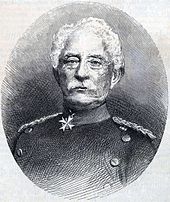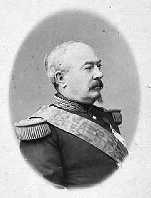Battle of Colombey
| date | August 14, 1870 |
|---|---|
| place | Colombey , Lorraine |
| output | German victory |
| Parties to the conflict | |
|---|---|
| Commander | |
| Troop strength | |
| 67,500 | 83,500 |
| losses | |
|
1,189 dead, 3,590 wounded and 127 missing |
377 dead, 2,641 wounded, 490 missing |
Franco-German War (1870–1871)
Weißenburg - Spichern - Wörth - Colombey - Strasbourg - Toul - Mars-la-Tour - Gravelotte - Metz - Beaumont - Noisseville - Sedan - Sceaux - Chevilly - Bellevue - Artenay - Châtillon - Châteaudun - Le Bourget - Coulmiers - Battle of Havana - Amiens - Beaune-la-Rolande- Villepion - Loigny and Poupry - Orléans - Villiers - Beaugency - Nuits - Hallue - Bapaume - Villersexel - Le Mans - Lisaine - Saint-Quentin - Buzenval - Paris - Belfort
The Battle of Colombey-Nouilly was a battle of the Franco-German War . It took place on August 14, 1870 east of Metz near two villages after which it is named. In the French-speaking world, it is also known as Bataille de Borny or Bataille de Courcelles .
prehistory
The Commander-in-Chief of the French Army on the Rhine, Marshal Bazaine , had withdrawn from the border to the fortress of Metz with five corps because of the threat of being surrounded by the German 2nd Army . On the evening of August 13, Bazaine had ordered his army to retreat west across the Moselle . The strategic goal was to join forces with the Châlons army under Marshal Mac-Mahon . To cover the passage on the Moselle, the French guard corps under Bourbaki was supposed to secure at Peltre with a front to the southeast. In the eastern approach of the fortress, the III. Corps under Decaen on the elevated terrain between Grigy, Colombey, Montoy and Nouilly, behind them to the north the IV Corps under General Ladmirault extended to Mey. On the German side, the German 1st Army under General Steinmetz advanced with two corps on Metz from the east. On the far right wing, the 3rd Cavalry Division under Graf von der Groeben reported that the French had evacuated all the terrain up to the Diedenhofen fortress and that no flank attacks were threatened from the north.
course
Early in the morning on August 14th, the French army began its retreat across the Moselle. The VI. Corps under Canrobert and the bulk of the French II Corps under Frossard had already crossed to the left bank of the Moselle when General von Manteuffel decided on his own to launch an attack at around 2 p.m. in order to hold the remaining French corps on the right bank of the Moselle. Bazaine stopped the further passage to the west and accepted the battle. Since the troops of the Prussian I Army Corps were still lagging behind, the German VII Corps , which had already arrived further south, under General Adolf von Zastrow, was to initiate the first attack with the 13th Division immediately.
The battle opened at 3:30 p.m. with the attack of the 26th Infantry Brigade under Major General von der Goltz . Before the major general went on the attack, he informed the following 14th division under Kameke as well as the division commanders of the 1st Corps of his intention in order to be sure of their support in the event of an enemy superiority. The attack was initially directed against Colombey , where the Germans lay the French 3rd Division (General Metman ) from III. Corps opposite. The French had a position well protected by the terrain, so that the Germans had a difficult position, especially since the French were far superior to them in numbers. Two battalions of Infantry Regiment No. 15 under Colonel von Delitz advanced on Aubigny Castle, the 7th Jäger were deployed on the left via Ars Laquenexy on Colombey, Infantry Regiment No. 55 followed via Marsilly. The first attempt was the village of Colombey and the height at La Planchette.
After about an hour of fighting, the situation for the 26th Brigade at Coincy became critical. Then a light battery of the 1st Army Corps arrived as the first reinforcement and took up position southwest of Montoy. Two batteries of the 2nd Division drove up shortly afterwards between Montoy and Noisseville. When the 25th Brigade under General Osten-Sacken arrived on the left wing, the critical situation was over. This was sent to the left wing by General Gluemer , commander of the 13th Division. When the commanding general of the VIII. Army Corps, General von Zastrow, appeared on the battlefield, he immediately sent the vanguard of the 28th Brigade under General von Woyna to support this section, the 27th Brigade remained in reserve. The tough 26th Brigade received the necessary support, the 25th Brigade pushed the enemy back to Borny and Bellecroix.
The left wing of the Prussian I. Army Corps attacked with the 1st Division under Lieutenant General von Bentheim opposite the French Grenier Division between Montoy and Noisseville . At 5 p.m. Montoy was captured, and the 43rd Infantry Regiment under Colonel von Bosse stormed the village of Lauvallier after heavy losses. Although they advanced as far as Mey , they had to fall back on Montoy before the reinforcements sent by General Ladmirault, where a three-time attack by the French was repulsed with great loss. While the battle on the heights of Colombey was stabilized, the situation of the Prussian 2nd Division under General von Pritzelwitz on the right wing around Nouilly remained serious. The beleaguered 3rd Brigade of General von Memerty was finally relieved after 90 guns had been driven between Servigny and Noiseville.
The fight was only decided at 6.30 p.m. when the main body of the I. Corps and at 6.45 p.m. the 14th Division appeared at Colombey . At the same time from the south the 1st Cavalry Division under General Hartmann and the 18th Division under General von Wrangel from the IX. Army Corps advanced against the right flank of the French position near the village of Mercy le Haut. General Deligny , commander of the 1st Division of the Guard Corps, had the brigade under Brincourt evacuate not only the village of Grigy, but also the good positions in the Borny forest. On the north wing, infantry regiment No. 4 attacked the village of Villers l'Orme in the dark to secure the right wing. Lieutenant General von Bentheim was only able to recapture the heights at Lauvallier , which had been lost to the French Aymard division , with some thrown together parts of the 3rd, 4th, 43rd and 44th infantry regiments while it was still dark.
consequences
The French withdrew under the protection of the forts of Metz . General von Steinmetz also ordered the troops to march back to their starting positions, since he had no forces to pursue them, but he allowed parts to remain on the battlefield out of consideration for the wounded. The success for the Germans was that the French were stopped in their march on the left bank of the Moselle, which enabled the circumvention of the same after the battles of Mars-la-Tour and Gravelotte by the southern comprehensive 2nd Army .
The total loss of the Germans was approx. 5,000 men (1,189 dead, 3,590 wounded and 127 missing), that of the French only 3,600 men (377 dead, 2,641 wounded, 490 missing), which is explained by the covered position of the French. General Decaen died of his wounds on August 17th, whereupon the French III. Corps was commanded by General Lebœuf .
literature
- Theodor Fontane : The war against France 1870/71. Volume 1, Verlag Rockstuhl Bad Langensalza, Reprint 2004/2009 (1st edition: Berlin 1873), ISBN 978-3-937135-25-0 .
- Carl Bleibtreu : Battle of Colombey on August 14, 1870. Reprint 1906/2009 Verlag Rockstuhl , Bad Langensalza, ISBN 978-3-86777-073-6 .
- Justus Scheibert : The war between France and Germany 1870/71. after the great general staff works, Pauli's successor, Berlin 1895.
Individual evidence
- ^ Scheibert: The war between France and Germany 1870/71. Pauli's successor, Berlin 1895. p. 58
- ^ Justus Scheibert : The war between France and Germany 1870/71. Pauli's successor, Berlin 1895. p. 60
- ^ Justus Scheibert: The war between France and Germany 1870/71. Pauli's successor, Berlin 1895, p. 62 f.





